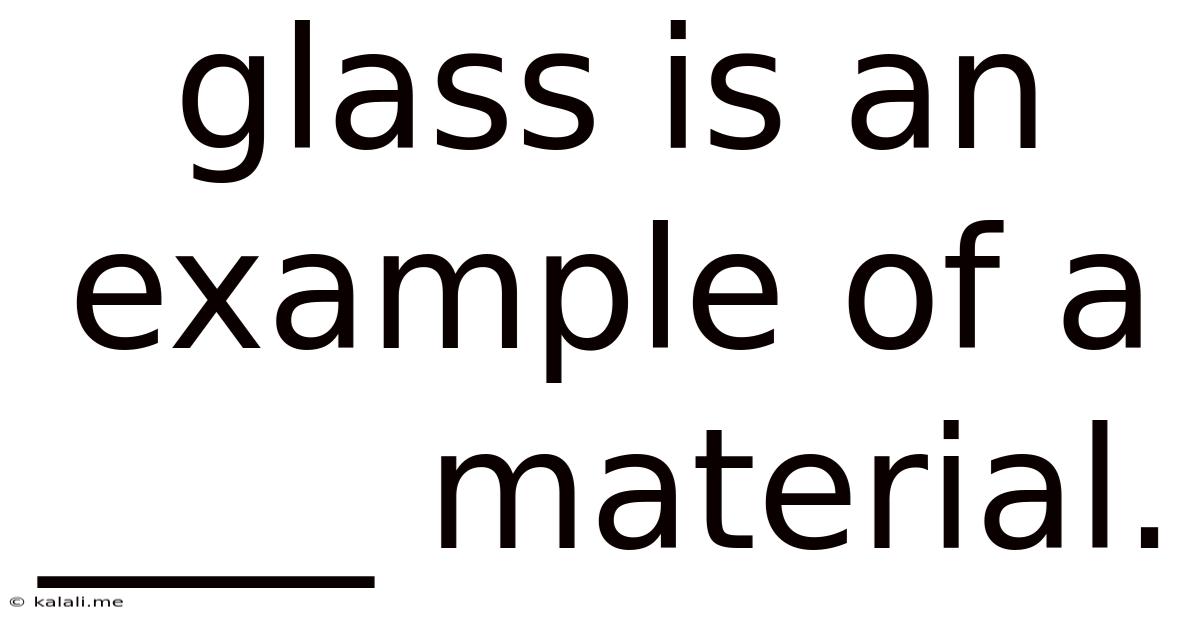Glass Is An Example Of A ____ Material.
Kalali
Jun 11, 2025 · 3 min read

Table of Contents
Glass: An Example of an Amorphous Material
Glass is a fascinating material, ubiquitous in our daily lives from windows and drinking glasses to sophisticated optical fibers. But what exactly is glass, from a material science perspective? The answer lies in its unique atomic structure: glass is an example of an amorphous material. This article will delve into what makes glass amorphous, exploring its properties and contrasting it with crystalline materials.
What is an Amorphous Material?
Unlike crystalline materials which possess a highly ordered, repeating atomic structure (think of the perfectly arranged atoms in a diamond), amorphous materials lack this long-range order. Their atoms are arranged randomly, similar to a liquid frozen in place. This lack of order gives amorphous materials unique properties. Imagine trying to build a brick wall (crystalline) versus trying to build a wall out of randomly shaped and sized rocks (amorphous) – the resulting structures are very different in terms of strength, stability, and overall appearance.
The Amorphous Nature of Glass
Glass's amorphous nature arises from its rapid cooling process. When molten glass cools quickly, the atoms don't have enough time to arrange themselves into a regular crystalline structure. They become trapped in a disordered, glassy state. This is why glass is often described as a "supercooled liquid"—it behaves like a very viscous liquid at room temperature, though extremely slowly. This is evident in the very slow flow of very old glass windows, where the bottom is noticeably thicker than the top over centuries.
Properties of Amorphous Materials (and Glass)
Several properties distinguish amorphous materials, including glass, from their crystalline counterparts:
- Isotropic: Amorphous materials exhibit similar properties in all directions, unlike crystalline materials which can have different properties along different crystallographic axes. This isotropy makes glass suitable for applications requiring uniform optical properties.
- Brittle: Due to the lack of long-range order, amorphous materials, including glass, are generally brittle and prone to fracture under stress.
- Transparent (in certain cases): The random arrangement of atoms in glass minimizes scattering of light, resulting in its transparency, a crucial property for windows and optical components.
- Variable Properties: The properties of glass can be tailored by adjusting its chemical composition. Adding different elements alters its melting point, refractive index, and other characteristics. This allows for the creation of specialized glasses for various applications, including high-strength glass, heat-resistant glass, and lead crystal glass.
Contrast with Crystalline Materials
To further understand the amorphous nature of glass, let's contrast it with crystalline materials:
| Feature | Amorphous (Glass) | Crystalline (e.g., Quartz) |
|---|---|---|
| Atomic Structure | Random, disordered | Ordered, repeating |
| Melting Point | Gradual softening | Sharp melting point |
| Hardness | Relatively low | Varies greatly depending on material |
| Brittleness | High | Varies greatly depending on material |
| Transparency | Often transparent | Can be transparent or opaque |
Applications of Glass
The unique properties of glass make it invaluable in numerous applications:
- Construction: Windows, doors, facades
- Packaging: Bottles, jars
- Optics: Lenses, prisms, optical fibers
- Electronics: Displays, substrates
- Art and Decoration: Sculptures, tableware
In conclusion, glass serves as a prime example of an amorphous material. Its disordered atomic structure dictates its properties, making it a versatile and essential material in countless modern applications. Understanding the amorphous nature of glass helps us appreciate its unique characteristics and the wide range of possibilities it offers for innovation and technological advancement.
Latest Posts
Latest Posts
-
How Many Days Are In 9 Years
Jul 01, 2025
-
How Much Is 1 8 And 1 8 Teaspoon
Jul 01, 2025
-
How Many Feet In A Quarter Acre
Jul 01, 2025
-
How Many Feet Is Half An Acre
Jul 01, 2025
-
If I Was Born In 2004 How Old Am I
Jul 01, 2025
Related Post
Thank you for visiting our website which covers about Glass Is An Example Of A ____ Material. . We hope the information provided has been useful to you. Feel free to contact us if you have any questions or need further assistance. See you next time and don't miss to bookmark.